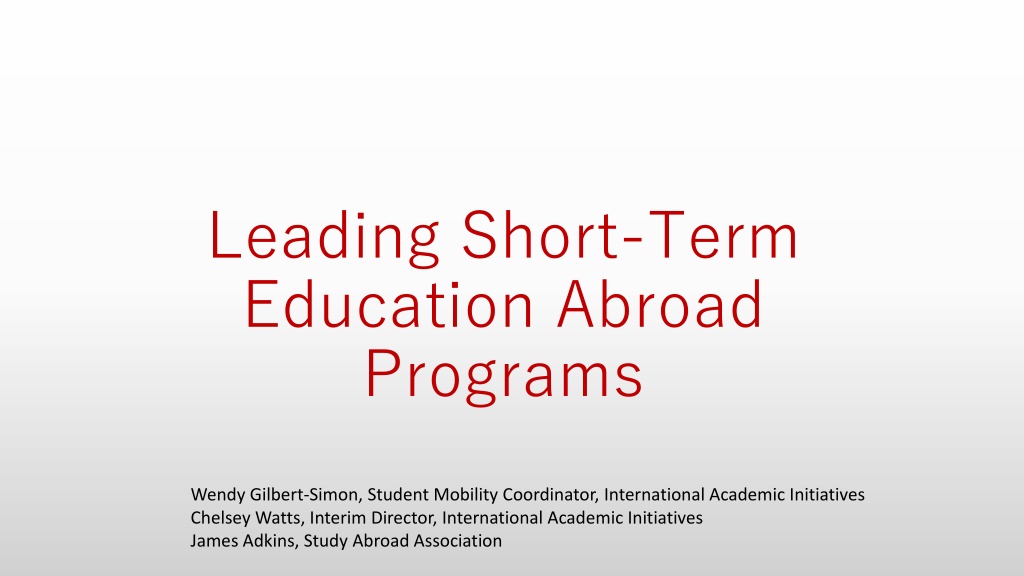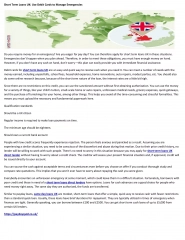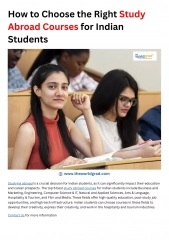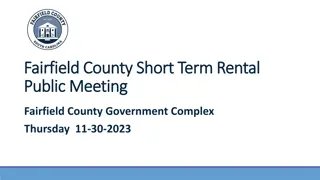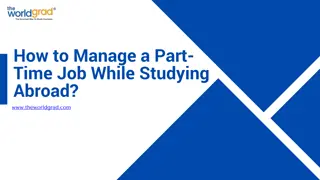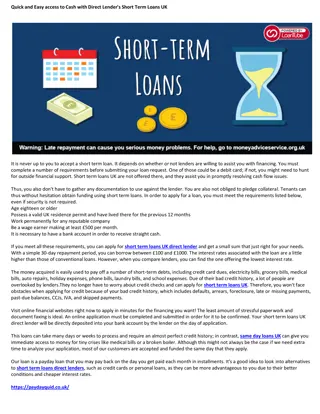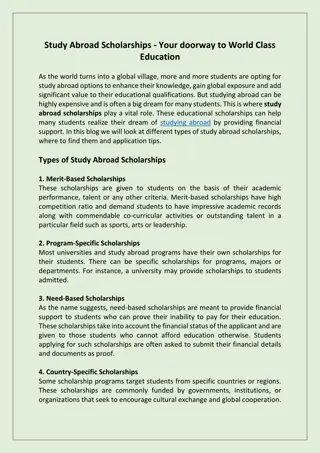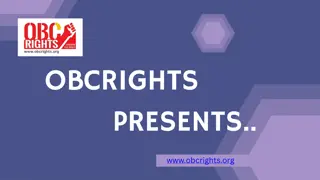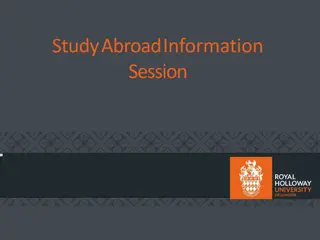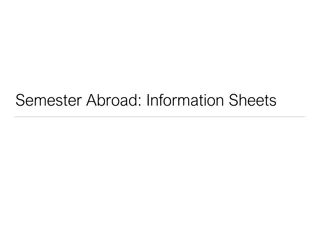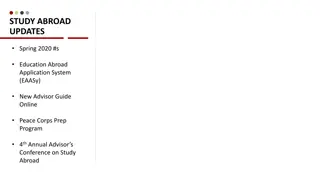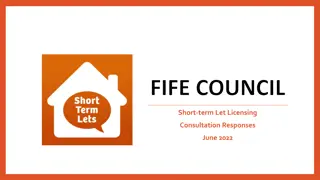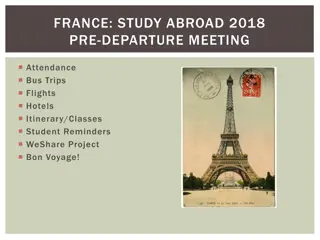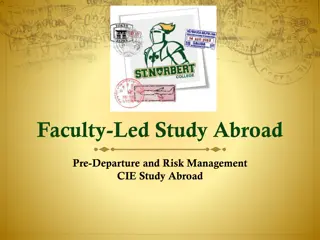Faculty-Led Short-Term Study Abroad Programs
Discover the numerous benefits of studying abroad through faculty-led short-term programs, including transformative experiences, personal growth, cultural awareness, and academic credits. Learn about program models, proposing courses, faculty leader roles, and partnerships with key organizations for a rewarding educational journey.
Download Presentation

Please find below an Image/Link to download the presentation.
The content on the website is provided AS IS for your information and personal use only. It may not be sold, licensed, or shared on other websites without obtaining consent from the author.If you encounter any issues during the download, it is possible that the publisher has removed the file from their server.
You are allowed to download the files provided on this website for personal or commercial use, subject to the condition that they are used lawfully. All files are the property of their respective owners.
The content on the website is provided AS IS for your information and personal use only. It may not be sold, licensed, or shared on other websites without obtaining consent from the author.
E N D
Presentation Transcript
Leading Short-Term Education Abroad Programs Wendy Gilbert-Simon, Student Mobility Coordinator, International Academic Initiatives Chelsey Watts, Interim Director, International Academic Initiatives James Adkins, Study Abroad Association
Workshop Agenda: Why study abroad? Benefits of a Faculty-led Program Models of faculty-led programs Step-by-step process and timeline Elements of a strong study abroad course proposal Role of a program leader Faculty leader remuneration Partnering with IAI Partnering with SAA Q and A
WHY STUDY ABROAD? Benefits for Students: Transformative Experience Supports strategic plan Study abroad offers many benefits: Opportunity to see a different part of the world in its context. Personal enrichment, growth and independence. Deeper cultural awareness beyond films, media and the evening news. Fresh perspectives and ways of thinking about the world. Academic credit. Linguistic immersion from beginner to advanced levels. Experience that is prized by employers in a wide variety of fields.
Types of Study Abroad/Study Away Exchange through Partner Universities MSU currently has formal exchange agreements with 21 partners in 16 countries. Affiliated Programs MSU has formal agreements with several established study abroad program providers, offering hundreds of different programs around the world. National Student Exchange MSU students can study out of state at 160+ member institutions across the US and Canada for a semester or year, pay MSU tuition and earn credit toward their degree. Faculty-led Short Term Programs Each year, the Office of International Academic Initiatives works with faculty to develop and support a growing number of short term faculty led study abroad programs.
Why Faculty Led Programs Appeal to Students Why Faculty Led Programs Appeal to Students These unique opportunities provide high-impact learning experiences. Nationwide, most popular type of study abroad and growing. Attractive option for students Shorter time means less conflicts with part-time jobs Shorter time means less conflicts with family responsibilities Affordable options- group rates for airfare, hotels, guides, etc. Montclair State courses and credit, making academic progress Traveling with a known and trusted faculty member Traveling with a faculty member alleviates student and parental concerns about solo travel Traveling with a faculty member allows students expert insights on location, history, amenities
Why Leading a Program Is Appealing to Faculty Opportunity to provide expert insights on location, history, amenities Adapt and expand existing course syllabi Expand international connections for research Foster stronger relationships with students Travel to new or familiar destinations
THE FIVE PHASES OF DESIGNING AND THE FIVE PHASES OF DESIGNING AND IMPLEMENTING A FACULTY IMPLEMENTING A FACULTY- -LED PROGRAM LED PROGRAM
TYPES OF FACULTY LED PROGRAMS TYPES OF FACULTY LED PROGRAMS Exploration Seminar (Spring Break, Winter or Summer) a stand-alone course offered during spring break (one credit) or winter (1-3 credits) typically between 7-14 days of travel single city or region to ensure students have the best opportunity to explore the location and the subject material and to keep the program cost efficient. limited opportunities for independent student or faculty travel. Two leaders unless approved by IAI.
TYPES OF FACULTY LED PROGRAMS TYPES OF FACULTY LED PROGRAMS Global+ Embedded Program (Spring, Winter or Summer) embedded in a three credit spring semester, winter or summer session course. travel component occurs during either spring break, or for a short period during winter or summer session approximately 7-14 days. limited opportunities for independent student or faculty travel. Two leaders unless approved by IAI
TYPES OF FACULTY LED PROGRAMS TYPES OF FACULTY LED PROGRAMS Summer School Abroad faculty guided immersion program approximately 3-8 weeks, three or six-credit often located on the campus or facility of an international partner significant classroom instruction complemented by cultural experiences and excursions. students and faculty have the opportunity outside of class time for independent travel and exploration. option for single leader depending on in- country support.
What does a Program Leader Do? What does a Program Leader Do? Faculty leaders have a wide range of responsibilities and roles. They don many hats throughout the various stages, from proposal to preparation and implementation. Before departure: Envision how a course can be enhanced by international immersion Develop an outline (abstract): what, where, when, who Work with IE to conceive itinerary Recruit Students (IAI and/or SAA will provide marketing materials) Interview applicants Participate in pre-departure orientations While Abroad: Teach course and facilitate activities Manage daily group dynamics Serve as crisis manager and liaison to MSU for any emergency After Return: Participate in a reflective activity with students (hopefully built into course design) Provide feedback to IAI
International Academic Initiatives is your partner throughout! General: Develop policies, processes, guidelines, risk management protocols and external partnerships Before departure: Guide and advise faculty on program development Review proposals across disciplines and destinations, identify opportunities for collaborations Work with external partners (eg SAA, travel agents) to develop detailed itineraries Develop program budgets, collect student payments, pay vendors Develop marketing materials (or SAA will provide marketing materials) Build, collect and review applications for eligibility Lead pre-departure orientations While Abroad: Serve as primary contact for any emergencies After Return: Review feedback for improvements
PROGRAM PROPOSAL TIMELINE PROGRAM PROPOSAL TIMELINE
CONSIDERATIONS FOR PROPOSAL REVIEW CONSIDERATIONS FOR PROPOSAL REVIEW Risk Management (travel advisories, on-the-ground support, etc.) Support within the college/department Feasibility: Affordability Target student population Complexity of logistics Academic Framework Faculty Leader Eligibility IAI capacity
Risk Management Risk Management Health, safety, and security are the number one priorities in program development, implementation, and management. Programs must ensure safe, clean, and hospitable student housing Co- or extra-curricular activities must offer responsible health, safety, and security measures. Facilities and infrastructure must provide a safe environment and accommodate students of varying needs and abilities.
Academic Support It is the intention of the Office of International Academic Initiatives to support programs that academic chairs and deans have determined are well integrated into the objectives of the college and department.
Academic Content and Integrity Academic Content and Integrity Destination is integral to academic content Comparable academic rigor to on campus course Meet learning outcomes not met by an existing study abroad program Credit hour equivalency to on campus programs Curriculum supports the program goals and leverages the unique learning opportunities offered by the international context Pre-program, on-site, and post-program offerings support the continuity of student learning and development and provide opportunities for intercultural learning and growth
Program Design and Financial Feasibility Program Design and Financial Feasibility When designing programs faculty should ensure programs are accessible, affordable and attractive. Programs should be: Integrated into the curriculum and preferably meet major/minor, or general education requirements. Balance the learning goals of the program with the cost of travel. Meet the needs of a large enough group of students to run. Student enrollment Target 15-24 students for two leader programs Summer School Abroad minimum 10 students per leader. IAI is responsible for setting program budgets and determining the final program cost to students.
Faculty Leader Eligibility Faculty must be full-time tenured, or tenure-track faculty. Instructional Specialists will also be eligible if their contract allows. Faculty who are on sabbatical may not lead any program during the entire term of the sabbatical. Adjunct faculty are not eligible to serve as program leaders or second leaders. Full-time non-teaching staff may serve as second leaders.
FACULTY LEADER REMUNERATION FACULTY LEADER REMUNERATION Teaching Salary Spring Semester: Salary is paid to the faculty member through the faculty member s department. Summer or Winter Session: Faculty are paid by Summer/Winter Sessions according to the established teaching rates. A second faculty leader or administrator who is not teaching a course will not be paid a teaching salary for the program.
Faculty Leader Remuneration, cont. Expenses of Program All costs of the program are covered, typically including: Roundtrip airfare Housing in a single room or similar, depending on location Local transportation included in the student program Airport transfers Enrollment fee for travel assistance policy Group meals included in the student program International phone service
Faculty Leader Remuneration, cont. Expense Reimbursement Faculty leaders will be reimbursed for meals and incidental expenses during the program, in accordance with University guidelines. Amount varies in accordance with the length of the program.
PARTNER ORGANIZATIONS MSU has partnered with a custom faculty-led program provider who can assist with designing and delivering programs. Visit the Study Abroad Association website to view sample itineraries. SAA programs are fully customizable to meet you academic needs. SAA handle all the logistics and provide an in-country manager and support for the duration of your program. Can offer programs in 30+ countries. SAA does not have a sole source contract so we can consider other organizations if they are better able to meet the academic needs of the program
WHAT TO DO NEXT WHAT TO DO NEXT Visit IAI s website to explore proposal process Talk to your Chair and colleagues in your department Explore the Study Abroad Association website Explore your professional networks Schedule a meeting with IAI to discuss your idea (Wendy or Chelsey)
CURRICULUM RESOURCES CURRICULUM RESOURCES The Forum on Education Abroad The Education Abroad Digital Resource Center The Curriculum Toolbox Montclair State University is a member so you can request access to their web resources. https://forumea.org/resources/curriculum/curriculum-resources/
